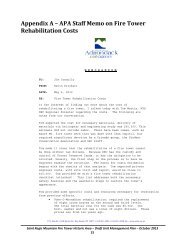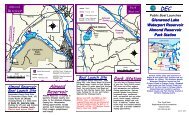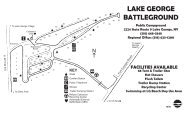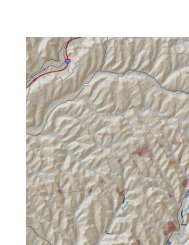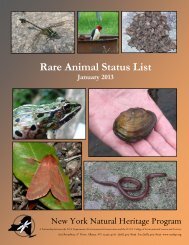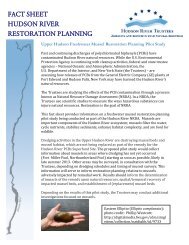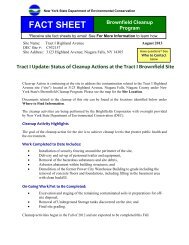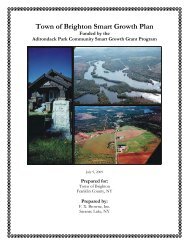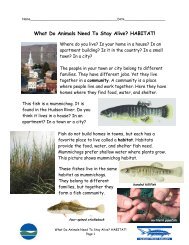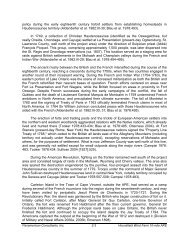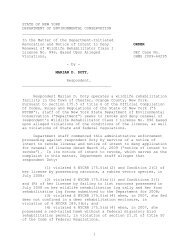2012-2013 Hunting & Trapping Regulations Guide - New York State ...
2012-2013 Hunting & Trapping Regulations Guide - New York State ...
2012-2013 Hunting & Trapping Regulations Guide - New York State ...
You also want an ePaper? Increase the reach of your titles
YUMPU automatically turns print PDFs into web optimized ePapers that Google loves.
aCCess to HuNtING areas<br />
For information, go to www.dec.ny.gov/<br />
outdoor/7844.html.<br />
private lands<br />
Always ASK landowner permission to hunt on<br />
private land. If it were your land, how would<br />
you want a visitor to act?<br />
• Be courteous—ASK permission well in<br />
advance.<br />
• ASK what is permitted. What species can be<br />
hunted? Are tree stands allowed?<br />
• ASK if friends can join you.<br />
• Exercise safety—always!<br />
• Thank the landowner.<br />
Many landowners use ASK permission<br />
stickers on their signs which show the landowners’<br />
willingness to allow access to their<br />
lands. They are available for free from your<br />
local regional wildlife office (see page 8)<br />
or from DEC, 625 Broadway, Albany NY<br />
12233-4754. For more information on<br />
hunting on private lands, visit our website:<br />
www.dec.ny.gov/outdoor/7844.html.<br />
Remember: Damaging bark or cutting trees,<br />
branches or plants is illegal without permission<br />
of the landowner.<br />
Rights of way, such as for power lines and<br />
railroads, that cross private property are NOT<br />
public land. Trespassing on these areas without<br />
permission from the landowner is illegal.<br />
Did you know?<br />
....In 2011, DEC Forest Rangers<br />
made 69,923 inspections of<br />
state land trailheads, walked<br />
3,428 miles of state land<br />
boundary lines and checked<br />
11, 279 occupied campsites.<br />
Rangers taught 4,244 people<br />
how to safely use public lands.<br />
...DEC Forest Rangers are<br />
experts on all aspects of the<br />
state land they patrol. Ask a<br />
Ranger where to hunt, fi sh,<br />
hike, camp or see wildlife!<br />
...DEC Forest Rangers<br />
conducted 281 search and<br />
rescue missions in 2011, 70% of<br />
which occurred on state lands.<br />
www.dec.ny.gov<br />
518-408-5850<br />
<strong>New</strong> <strong>York</strong> <strong>State</strong><br />
DEPARTMENT OF<br />
ENVIRONMENTAL CONSERVATION<br />
fwma COOperative areas<br />
Through cooperative agreements under <strong>New</strong><br />
<strong>York</strong>’s Fish and Wildlife Management Act<br />
(FWMA), Cooperative <strong>Hunting</strong> Areas provide<br />
access and management services to privatelyowned<br />
lands in order to increase public hunting<br />
opportunities. When using these areas, remember<br />
that you are a guest on private property.<br />
Littering and other abuses will only result in<br />
closure of many excellent hunting areas.<br />
a wOrd aBOut liaBilitY<br />
Whether or not the land is posted, <strong>New</strong> <strong>York</strong><br />
<strong>State</strong> General Obligations Law protects landowners<br />
from liability for non-paying recreationists<br />
engaged in hunting, trapping and fishing<br />
on their property. Because of this protection,<br />
recreational liability lawsuits against rural<br />
landowners are uncommon. This protection<br />
does not apply in cases of willful or malicious<br />
failure to guard or warn against dangers.<br />
state lands<br />
For information on hunting and trapping<br />
opportunities and rules governing the use of<br />
state land, contact the regional office for the<br />
county where you would like to hunt or trap<br />
(see page 8). Wildlife staff can provide<br />
information on wildlife management areas<br />
(WMAs) and Cooperative <strong>Hunting</strong> Areas.<br />
Forestry staff and NYS Forest Rangers can<br />
provide details on state forest lands and the<br />
forest preserve. In some instances, written<br />
permission or permits are required to use state<br />
areas. These are available from DEC regional<br />
offices during normal business hours.<br />
mOtOrized aCCess tO state lands<br />
DEC has designated roads and trails on state<br />
forests and wildlife management areas and on<br />
roads in the forest preserve for motor vehicle<br />
use by authorized people with disabilities who<br />
have a mobility impairment. The list of these<br />
opportunities, along with information on how<br />
to obtain a statewide permit for this purpose,<br />
is available by writing to the Regional Land<br />
Manager at DEC regional offices (see page 8).<br />
wildlife management areas<br />
The Division of Fish, Wildlife, and Marine<br />
Resources manages about 187,000 acres of<br />
wildlife management areas. These areas are<br />
located throughout the state and contain a<br />
variety of different types of habitat and wildlife.<br />
They are managed primarily for wildlife and<br />
wildlife-related public use.<br />
WMAs have specific use regulations in<br />
addition to the general use regulations for<br />
state land. <strong>Hunting</strong>, trapping, and fishing are<br />
permitted, except as specifically restricted by<br />
posted notice.<br />
On wildlife management areas, it is unlawful<br />
to:<br />
• Camp without written permission<br />
• Travel off-road by use of motorcycles, motor<br />
scooters, mopeds, trail bikes, snowmobiles or<br />
any other motorized vehicle, except as specifically<br />
allowed by a permit or posted notice<br />
• Remove, cut or willfully damage or destroy<br />
living vegetation of any kind<br />
• Construct or place a permanent structure,<br />
blind, stand or platform (includes placement<br />
of nails or other hardware into trees)<br />
• Leave any personal property at the time of<br />
leaving the area<br />
• Enter upon property posted with No Trespassing<br />
signs, except with written permission<br />
from DEC<br />
lands and fOrests<br />
The Division of Lands and Forests manages<br />
nearly 4,000,000 acres of land, located in<br />
almost every county of the state. From the<br />
remote locations of the Adirondack and Catskill<br />
mountains to the rolling hills of the western<br />
parts of the state and the forested areas on Long<br />
Island, a wide range of hunting and trapping<br />
opportunities await the outdoor recreationist.<br />
fOrest preserve<br />
<strong>Hunting</strong> and trapping are permitted in the<br />
Adirondack and Catskill Forest Preserves.<br />
<strong>State</strong>-owned lands located within these<br />
preserves are designated “Forever Wild.” All<br />
state land rules and camping requirements<br />
apply to the preserves, as well as additional rules<br />
specific to certain areas. Contact the regional<br />
DEC office or nearest NYS Forest Ranger for<br />
further information.<br />
state parks<br />
Many state parks offer waterfowl, small<br />
game and big game hunting. For more<br />
information, contact the appropriate DEC<br />
regional office or visit the state parks website<br />
(http://nysparks.state.ny.us/parks/). Call each<br />
state park to find out specific hunting and<br />
access regulations. For a listing of state parks<br />
that allow deer hunting, visit the DEC website:<br />
http://www.dec.ny.gov/outdoor/7844.html<br />
state fOrest<br />
(refOrestatiOn land)<br />
Outside the Adirondacks and Catskills, reforestation<br />
areas are the most common type of<br />
state lands. Many recreational activities can<br />
be pursued on reforestation areas, including<br />
hunting and trapping. Reforestation areas are<br />
marked with signs saying “<strong>State</strong> Forest.”<br />
In some instances, permits are required to<br />
camp overnight on undeveloped state forest<br />
lands. Unless specifically prohibited, groups of<br />
less than 10 people may camp on state forest<br />
lands (other than developed campgrounds and<br />
wildlife management areas) for three nights<br />
without a permit. To camp for four nights or<br />
more, a permit must be obtained. Groups of<br />
10 or more people need a permit to camp on<br />
such lands for one night. Further information<br />
may be obtained from DEC regional offices for<br />
the county you want to camp in or from local<br />
NYS Forest Rangers.<br />
Use of all terrain vehicles (ATVs)<br />
and off road vehicles (ORVs) is<br />
restricted on most state land.<br />
60 <strong>2012</strong>–13 HuNtING & traPPING GuIDe



